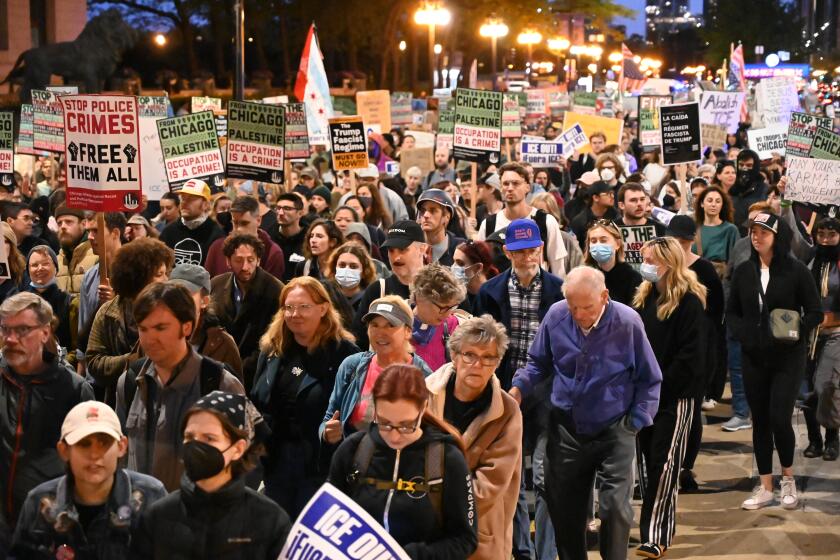The streets were quiet just a block from the ICE processing facility where the National Guard deployed Thursday to protect federal agents and property.
Residents walked their dogs. Kids went to and from school. An Amazon delivery driver parked his van on the side of South 24th Street, turned on his hazard lights and dropped off a few packages — seemingly unhurried or concerned about the dozen people chanting and carrying signs outside the facility on South 25th street.
Broadview, a suburb of roughly 8,000 people 12 miles west of downtown Chicago, has become a focal point in President Trump’s immigration crackdown in Illinois. It’s where in the last couple of weeks Immigration and Customs Enforcement agents shot a peacefully protesting Presbyterian pastor in the head with a pepper ball, and where dozens of protesters and journalists have been tear-gassed and hit with pepper balls.
Broadview Mayor Katrina Thompson, 55, shook her head when asked about the military presence, and said the whole situation seemed unnecessary and overblown.

Broadview Mayor Katrina Thompson. (Mayor Katrina Thompson FB)
“It’s calm in the city of Chicago. It’s no different than most major cities. Sure, it has issues. They all do. But they don’t call for the National Guard,” she said. “The last time I remember a National Guard coming in to a city was with Rodney King. But that was different. People were enraged. There were riots in the streets. People were looting shops and businesses. There is nothing like that happening here.”
Thompson grew up in Inglewood and graduated from Inglewood High School in 1988. She was in Los Angeles during the 1992 riots and keenly remembers the rage, violence and fear.
She’s adamant that what happened then has no comparison to what’s happening in Chicago now.
This week, about 200 Texas National Guard troops and 300 Illinois National Guard troops were deployed to the Chicago area by Trump to protect federal agents and property from protesters. About 20 California National Guard troops were also pulled into political battle, deployed to provide “refresher training,” the North American Aerospace Defense Command said in a statement. “These California National Guard soldiers will not be supporting the Federal Protection Mission in Illinois.”
On Thursday afternoon, a federal judge in Chicago entered a 14-day temporary restraining order preventing the federalization and deployment of the National Guard in Illinois. U.S. District Judge April Perry said she had “seen no credible evidence that there is a danger of rebellion in Illinois” and described the Trump administration’s version of events as “simply unreliable.” She said National Guard troops would “only add fuel to the fire.”
In downtown Chicago, people are shopping. Going to work. On Wednesday night, after a protest had formed downtown near the Trump International Hotel & Tower, the streets were nearly deserted. A few young men were seen going into the Elephant & Castle pub near the Chicago Board of Trade building, while a happy-looking couple strolled along the Chicago Riverwalk, holding hands and giggling.
Thompson said she is not interested in jumping into the national political fray and is focused on the things that are important to her constituents — such as making sure that the streets are clean, that Broadview’s police and firefighters have the resources and support they need, and that her residents feel safe.
But Thompson did find herself in the spotlight last week when she denied Homeland Security Secretary Kristi Noem access to the Broadview Municipal Building’s bathroom.
Thompson said that it was nothing personal, but that Noem showed up, unannounced, with a camera crew and a videographer.
“She came with a whole bunch of military people dressed in their military gear. And I said I’m not letting you in here. We work here. We don’t know what your intent is. If she had good intentions, you know what professionals do? They call and make an appointment. They don’t show up unannounced with dozens of people carrying guns,” Thompson said.
Thompson is also suing the federal government for erecting a fence around the ICE facility that she fears could prevent her first responders from getting inside should someone — detainee, ICE agent or government official — need help.
“When we talk about people having strokes, every second matters,” she said. “If we can’t get to them, that person could be severely disabled for a lifetime, or lose their life because a decision was made — without consulting us — that that’s the way it should be.”
Outside the facility on Thursday, protesters were outnumbered roughly 4 to 1 by local, county and state law enforcement, as well as local and national media.
Kate Madrigal, 37, a homemaker, said she had come several times to the site to protest. Her husband is a naturalized citizen and together they have four children.
She said they live in fear that someone is going to take her husband or scare her kids, and she’s felt compelled to be bear witness and be present because “if my kids ask me what I did during this period to help, I want to tell them I was here. I did something.”
Next to her were two other women who have also been showing up with sporadic visits — driving from Aurora when their work schedules allow.
Jen Monaco and Maya Willis said they’ve also felt pulled to the site to keep an eye on the troops and show support for those being detained. Monaco said she often cleans up the debris left behind from the day before, and showed a reporter photos of rubber bullets, empty tear gas casements and spent pepper balls that she’d cleaned up.
She said until the media showed up in force Thursday, ICE agents had been harassing, scaring, and shooting at protesters with these kinds of crowd control devices. Agents have also shoved and assaulted protesters, they said.
Cook County sheriff’s police and the Illinois State Police were on scene, occasionally shouting into bullhorns when protesters or reporters crossed the concrete barriers that had been erected to create a protest zone or box.
At one point, a white man wearing a sombrero, poncho and fake mustache walked around and through the small group of protesters, yelling racial slurs and taunting them. He said he was there to represent “Mexicans for ICE” before taking off his shirt and challenging another protester to a fight.
The police moved him away but allowed him to continue calling out and chanting. A man in a Chicago Bears T-shirt egged him on and said the man looked like he worked out a lot.
Two other women showed up around the same time, with wigs, and yelled curses at the ICE officials and National Guard troops on the other side of the new chain-link fence surrounding the facility.
Thompson has instituted a curfew around the facility, allowing protests to occur only between f 9 a.m. and 6 p.m.
“We have business in the area and people need to get to work. We’ve got kids who need to get to school,” she said. “Let’s let them do what they need to do, and then you all can come in and protest.”
But some protesters thought the curfew violated their right to free speech. Robert Held, a Chicago-based trust and estate lawyer, received a citation about 7:45 am for having come to the site before curfew was lifted.
“I’m not going to pay it,” he said, suggesting he’d heard the violation could cost him $750. “The ordinance is invalidly based. It violates my 1st Amendment rights.”
This story originally appeared in Los Angeles Times.
